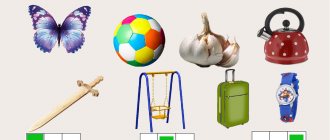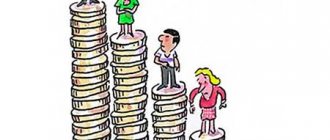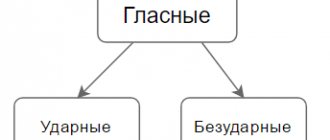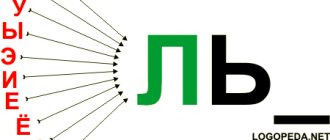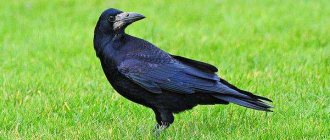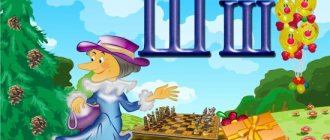Differentiation of sounds [A], [O] in a chain of sounds, words and sentences.
Summary of a subgroup speech therapy lesson
on working on sound pronunciation in children with special needs development
Topic:
“ Differentiation of sounds [O] - [A] ”
Prepared by:
Teacher - speech therapist
Kachkaeva Marina Sergeevna
Moscow, 2016
SUMMARY OF THE FRONT LESSON
IN THE MIDDLE GROUP No. 6
Topic: Differentiation of sounds [A], [O] in a chain of sounds, words and sentences.
Target:
teach to distinguish the sounds
A, O
Tasks:
| Educational task | Corrective task | Educational task |
| Distinguish the sounds A, O | Learn to isolate sounds from a series of vowels; | Cultivate a sustainable interest in classes, initiative, desire for active work, and independence in decision-making. |
| Select given vowel sounds from a number of sounds and words. | ||
| Improve phonemic awareness; auditory and visual attention and memory; | ||
| Develop sound analysis skills; | ||
| Replenish your vocabulary. |
Equipment:
pictures depicting dolls Olya and Ali, a soft ball, object pictures for the sounds [A], [O], soft modules, stripes, colored squares, colored pencils, magnets, pictures for shading (coloring).
Progress of the lesson:
1.Organizing time
Speech therapist:
Hello children! The girls came to visit us - Alya and Olya! They invite us to play.
Ball game " Hear and repeat "
Speech therapist:
I throw you a ball and say the words. You catch it and name the vowel sound you hear first.
Speech therapist:
Gosha/Savva repeat, what sound should you catch at the beginning or end?
For example:
A - a - aster - aster.
Speech therapist:
Whoever knows the answer does not shout, but waits for the ball to get to him. Whoever answers correctly sits down.
Material
: O - o - o - o - slick - Donkey, A - a - a - orange - Orange, O - o - o - hoop - Hoop, A - a - a - bus - Bus, O - o - o - island - Island.
2.
Distinguishing sounds A, O:
Speech therapist
: Guys, look, Alya tells us what our lips do when we pronounce the sound “A”. The sound “A” is a vowel sound. He loves the color red. When we pronounce it, the mouth is wide open.
Now let's look in the mirror what our lips do when they pronounce the sound "A"
Speech therapist
: Gosha/Savva what are sponges doing? Are your teeth visible? What does the tongue do?
Speech therapist:
Children, is the sound “A” a vowel or a consonant?
(If the children find it difficult to give an answer, then the speech therapist prompts: “It is a vowel sound.” You can sing it. The air comes out of the mouth freely.” If the children can answer the question on their own, then the prompts can be turned into questions to consolidate the children’s knowledge).
Speech therapist
: Guys, look, Olya tells us what our lips do when we pronounce the sound “O” The sound “O” is a vowel sound. He loves the color red. When we do it, our lips are round.
Now let's look in the mirror what our lips do when they pronounce the sound "O"
Speech therapist
: Gosha/Savva what are sponges doing? Are your teeth visible? What does the tongue do?
Speech therapist:
Children, is the sound “O” a vowel or a consonant?
(If the children find it difficult to give an answer, then the speech therapist prompts: “It is a vowel sound.” You can sing it. The air comes out of the mouth freely.” If the children can answer the question on their own, then the prompts can be turned into questions to consolidate the children’s knowledge).
3 .
Hearing selection.
Didactic game “Sounds are running”
(Children have envelopes with stripes and squares on their tables)
Speech therapist:
Children, take out the stripes and squares from your envelopes. Find the beginning of the strip. Where will our vowel sounds come from now? Who can show me where the stripe begins?
(The speech therapist makes sure that all children find the beginning of the stripe, the red line at its beginning, and place the stripe from left to right)
Speech therapist:
I will tell you the vowel sounds. Place as many squares on a strip as I named vowel sounds.
(The speech therapist also lays out a strip with the required number of sounds. He makes sure that all the children cope with the task. After the children have finished laying out the sounds on the strip, the speech therapist asks the questions “How many sounds ran along our strip?” “What sounds are these? Name them. ")
Material: A – O; U – I; A – O – I; U – O – A
Didactic game "Hide and Seek"
Speech therapist
: Guys, now we will look for the vowel sounds “A”, “O”. We stand behind our chairs. When you hear the sound “A”, we make our arms to the sides, and when the sound is “O”, we put our hands in the house above our heads. If you don't hear the sounds "A" or "O", hide behind your chairs.
Speech therapist:
Gosha / Savva repeat what you need to do when you hear the vowel sounds “A” or “O”? What will you do if you don't hear these sounds?
Material
:
A – M – O- P – A- D – O – B – A – M – O
Speech therapist:
Well done boys!
4. Physical education minute.
Guys, stand next to your chairs, now we’ll play. Listen to me carefully and do only what your ears hear. What your eyes see is wrong. We only do what our ears hear. Be careful, I may joke and do something wrong.
6. Didactic game “Resettlement”
(The speech therapist hands out material to the children that depicts two houses, and various pictures around them; you need to connect the pictures with the house so that one of them contains words with the sound “A”, the other with the sound “O”)
Speech therapist:
Guys, look at your leaves. Find two houses on them. Did you find everything? Find the top house. What sound lives there? The sound "A" lives there. Find the bottom house. What sound lives there? Sound "O"
Now let's move the pictures into the houses. In the house “A” there live pictures where the sound “A” is at the beginning of the word. In the "O" house there live pictures where the sound "O" is at the beginning of the word.
For example, the picture “Hoop” lives in the house “O”. Find the picture in the box above. Because the sound "O" is at the beginning of the word. (At the same time, the speech therapist explains to the children the meaning of this word)
Speech therapist:
Gosha/Savva, repeat what needs to be done with the pictures? What vowel sound lives in the upper house/in the lower one?
7.
Didactic game “Who is attentive?”
Speech therapist:
Calls the children one by one and shows them pictures (
at this time the necessary material is posted on the board).
Speech therapist:
Help me build a bridge.
Look at the pictures (the speech therapist names them)
What word do you think is missing? What are the children doing? Name it.
Repeat the entire sentence. ( Previously, the speech therapist lays out soft rectangles on the table so that children can work on the structure of the sentence, not only relying on hearing and vision, but can work on it tactilely, that is, each word in the sentence should be supported by a rectangle)
Speech therapist:
Find in this sentence the words where the sound “A” or “O” lives
.
Give these pictures to our guests.
Say, for example: On Olya Donkey
Material:
Olya EATS A TASTY, SWEET watermelon; Kolya CATCHED A BIG catfish; Olya is SITTING on a donkey; Kolya was given a SMALL, BEAUTIFUL gnome
8 .
Results of the lesson:
Speech therapist:
Children, our lesson is ending and now the one who will get up and come to the door will tell me what sounds you and I learned to distinguish today; who can tell me the words in which the sound “A” or “O” lives?
6
Elimination of confusion in writing the letters i-u, l-m in primary schoolchildren.
Task 3
. Write the words in two columns: in the first - with the letter “l”, in the second with - “m”. (Words suggested: varnish, poppy, puddle, chalk, boat, car, treasure, watering can, fly...)
Stage 6
. Differentiation of “l-m” in phrases. Task 1. Decipher the phrases by inserting the required letter “l-m” instead of the period. Zo.otoy ku.on .o.dress ba. Heavy.blanket.Sunflower oil.Sunflower oil.U.fish.adenza.
Stage 7
. Differentiation of “l-m” in sentences, proverbs, sayings. Task: Insert the letters “l-m”.
• In do.gah – as in she.kah. • Silence is a sign of congruent Asia. • Bring your teeth back to life. • Go.ova is gray-haired, but her soul is .young. • U.enie – po.ovina de.a. • Whoever eats eats. • If only there were no bush. mi., so.ovey nests b not vi. • Where there are many s.ov, that. little de.a. • U.elgo according to the s.ovs - un.elgo according to the .asics to see. • S.ovo tale. – str.u pos.al, pis.o writ. - the priest is in a trap. .
Stage 8
. Differentiation in texts.
Auditory dictation
. The sun's rays illuminated the earth. The bells rang throughout the square. People walked in crowds and sang. It was the month of May. I admired the young greenery.
Having tested these methods on my students in grades 2-3 at State Educational Institution No. 1607 in Moscow, I had the opportunity to observe how their level of self-control increased every day. When writing down words and sentences, I saw how diligently they stretched out their lips (when pronouncing words with the sound “u”) or, conversely, stretched them (when pronouncing the sound “i”), each time making fewer and fewer mistakes. It was interesting to notice how at first the children opened their mouths slightly, feeling the tongue rising upward (when pronouncing words with the sound “l”), or closed their lips (when sounding “m”) and wrote down the required number of elements. While working with parents, I also explained to them what to pay attention to. When children performed written work at home, parents first reminded them of this, and later began to celebrate their independent completion of these “exercises,” thereby achieving the necessary results. Thus, by the end of the year, out of 8 identified students with the described disorder, 7 had their errors completely eliminated, and 1 had their number sharply reduced (I associate the residual effects with rare attendance at speech therapy classes due to the child’s frequent illness.) Literature.
1. Articulation of sounds in a graphic image. Educational and demonstration material. Appendix to the book by E.V. Novikova “Speech therapy alphabet. New methodology for teaching reading." - M.: Publishing house. GNOM and D, 2003.
2. Efimenkova L.N. Correction of oral and written speech for primary school students: A manual for speech therapists. – M.: Humanite. publishing center VLADOS, 2001.
3. Lalaeva R.I. Speech therapy work in correctional classes: Book. For a speech therapist. – M.: Humanite. published VLADOS center, 1999.
4. I.N. Sadovnikova Impaired written speech in younger schoolchildren: Textbook - M.: VLADOS, 1997.
5. Paramonova L.G. Prevention and elimination of dysgraphia in children. St. Petersburg, ed. "UNION", 2001
